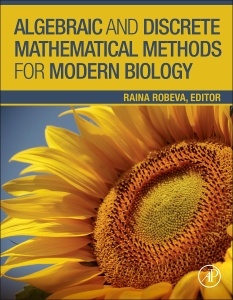Description
Algebraic and Discrete Mathematical Methods for Modern Biology
Coordinator: Robeva Raina
Language: English
Subjects for Algebraic and Discrete Mathematical Methods for Modern...:
382 p. · 21.4x27.6 cm · Hardback
Description
/li>Contents
/li>Readership
/li>Biography
/li>Comment
/li>
Written by experts in both mathematics and biology, Algebraic and Discrete Mathematical Methods for Modern Biology offers a bridge between math and biology, providing a framework for simulating, analyzing, predicting, and modulating the behavior of complex biological systems. Each chapter begins with a question from modern biology, followed by the description of certain mathematical methods and theory appropriate in the search of answers. Every topic provides a fast-track pathway through the problem by presenting the biological foundation, covering the relevant mathematical theory, and highlighting connections between them. Many of the projects and exercises embedded in each chapter utilize specialized software, providing students with much-needed familiarity and experience with computing applications, critical components of the "modern biology" skill set. This book is appropriate for mathematics courses such as finite mathematics, discrete structures, linear algebra, abstract/modern algebra, graph theory, probability, bioinformatics, statistics, biostatistics, and modeling, as well as for biology courses such as genetics, cell and molecular biology, biochemistry, ecology, and evolution.
Preface 1. Graph Theory for Systems Biology: Interval Graphs, Motifs, and Pattern Recognition John R. Jungck and Rama Viswanathan 2. Food Webs and Graphs Margaret Midge Cozzens 3. Adaptation and Fitness Graphs Kristina Crona and Emilie Wiesner 4. Signaling Networks: Asynchronous Boolean Models Réka Albert and Raina Robeva 5. Dynamics of Complex Boolean Networks: Canalization, Stability, and Criticality Qijun He, Matthew Macauley and Robin Davies 6. Steady State Analysis of Boolean Models: A Dimension Reduction Approach Alan Veliz-Cuba and David Murrugarra 7. BioModel Engineering with Petri Nets Mary Ann Blätke, Monika Heiner and Wolfgang Marwan 8. Transmission of Infectious Diseases: Data, Models, and Simulations Winfried Just, Hannah Callender, M. Drew LaMar and Natalia Toporikova 9. Disease Transmission Dynamics on Networks: Network Structure Versus Disease Dynamics Winfried Just, Hannah Callender and M. Drew LaMar 10. Predicting Correlated Responses in Quantitative Traits Under Selection: A Linear Algebra Approach Janet Steven and Bessie Kirkwood 11. Metabolic Analysis: Algebraic and Geometric Methods Terrell L. Hodge, Blair R. Szymczyna and Todd J. Barkman 12. Reconstructing the Phylogeny: Computational Methods Grady Weyenberg and Ruriko Yoshida 13. RNA Secondary Structures: Combinatorial Models and Folding Algorithms Qijun He, Matthew Macauley and Robin Davies 14. RNA Secondary Structures: An Approach Through Pseudoknots and Fatgraphs Christian M. Reidys
Students and researchers in biomathematics, mathematics, and biology
- Examines significant questions in modern biology and their mathematical treatments
- Presents important mathematical concepts and tools in the context of essential biology
- Features material of interest to students in both mathematics and biology
- Presents chapters in modular format so coverage need not follow the Table of Contents
- Introduces projects appropriate for undergraduate research
- Utilizes freely accessible software for visualization, simulation, and analysis in modern biology
- Requires no calculus as a prerequisite
- Provides a complete Solutions Manual
- Features a companion website with supplementary resources




